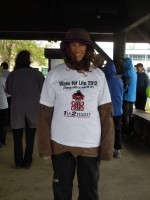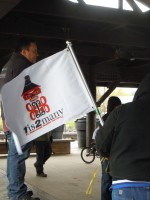No halibut on deck here… Consistent storms have tethered us to the dock for two weeks, waiting out weather like 45 knot winds and 22-foot seas. We take it for what it is – what else can you do? – but watching steady gray sheets pouring down the cabin windows gets old.
So I go for a walk.
Southeast Alaska’s second annual Walk for Life is scheduled to gather at Crescent Harbor at 12:30. Scoping the scene from across the street, I see three people huddled against snarling wind and icy shards of rain. Oh, man… But taking a public stand against suicide seems especially necessary on such a grim day. I yank my hood up and head over.

Others feel similar urgency. Over the next half-hour, about 50 people fill the harbor shelter: cane-bearing elders, bundled children, young couples. Organizers from the SouthEast Alaska Regional Health Consortium (SEARHC) hand out T-shirts emblazoned with The Watchman, a symbol of courage designed by Tlingit artist Robert Hoffmann.
With everyone decked out and ready to march, SEARHC Suicide Prevention Program Manager Wilbur Brown calls for our attention. “If you’ve been around Alaska at all,” he begins, “you know there’s a lot of suicides here.”
A lot of suicides… Statewide, Alaska doubles the national average, while rates in remote Arctic villages are up to seven times higher. From our mountains, salmon, and bears, to our chemical dependency, domestic violence, and despair, we have it all bigger, badder.
Wilbur explains that Walk for Life is a response to those staggering losses. Initiated in Kotzebue, the first walk took place in 2009. (150 people participated in nearby Ambler – almost half of the Kobuk River village’s population.) In 2011, Tessa Baldwin, a Kotzebue teenager, inspired Southeast Alaska to join. One year later, the prevention effort has been embraced statewide. “People are walking for life all over Southeast today – people are walking in Angoon, Hoonah, Kake, Klawock, everywhere. We’re walking to celebrate life and say no to suicide.”

So we walk. Led by a police escort, we march through an intersection (one of Sitka’s two stoplights) and down the main drag, winding around Saint Michael’s Russian Orthodox Church and turning to parallel the channel. We hold up traffic. One driver leans out her window with a smile. “What is this?” Her smile washes away with the answer.
We file into the Sheetka Kwaan Naa Kahidi house, where Wilbur opens the ceremony. He hopes that through events like these, we might lessen the taboo of talking about suicide. “Alaska’s highest suicide rates are among young men. And what do we teach our young men? We teach them not to talk, not to feel, not to communicate. We want to show them there’s another way.”
One of those ways may be through cultural revitalization. For the next several hours, Naa Kahidi pulses with tradition’s heartbeat. Accompanied by a single drum, four Ravens stand at the stage edge, voices raised in a sorrow song shared by Hoonah’s Sea Pigeon clan. A group of Eagles respond, keening loss that pierces through the rafters, through time and place, through language.
Nodding with the beat, I glance at the ink on my left forearm. Part of me for 13 years, this tattoo usually demands about as much conscious consideration as a pinky toe, but in this setting, the Viktor Frankl quote seems to glow. That which seeks to give light must endure burning.
I remember burning… Sitting mute in the psychiatrist’s office, consumed by blistering loneliness, resolute. (Nine years old, I’d already aced my family’s lessons on silence.) Another lifetime trapped within that flame. Alliances with alcohol, friends whose angst mirrored my own. Skin carved like pie crust to relieve the steam within.
I remember light… Blinking against newly broken dawn as I staggered into my tribe. People who offered hope, connection, the thrill of community. We strolled bold amongst dragons, confident we’d pass through without a scorch.
It’s been seven years since I was a practicing social worker. I exchanged the path of tending lives for one of taking life, hunting fish half the year, yet still I find myself whispering the names of those we lost. The young man who committed suicide by cop. The young woman who hung herself in jail. In a hospital. In a garage. With an overdose. With a shotgun. After being kicked out of the family for being gay. After seeming to have made it, whatever “made it” meant. Those we lost, and those we might have. Those whose despair feasted like parasites, those who crooked their fingers to death and silently screamed please.
I remember the hiss of light guttering out, echoed by the mechanical slurp of a stomach pump. By then I’d learned that if I sat very quietly – as still as the dead – and wiped my expression mountain stream clean, the ER personnel would let me stay with the kid I’d brought in. Studying the steady extraction of a young woman’s stomach contents, grainy residue awash in waves of Pepsi Blue, I wondered how I’d ever dared imagine I’d sidestep burn-out.
Back in Naa Kahidi, six drummers gather around the Hashagoon drum, centered on the main floor. “We’re going to do a song to honor those who’ve passed away from suicide,” one explains. “Please remove any head coverings and stand if you’re able to do so. You’re welcome to join us to dance if you’d like.”
A circle forms around the drummers. I study the pairs of Xtra Tufs and sneakers, all moving with differing degrees of certainty and grace. Shuffle, toe, step, toe, knees flex, shuffle. As the faces of my dead and might-have-beens shimmer against the dancers’ feet, it’s easy to meditate on the losses binding us.
But a child careens through the room. Arms outstretched and a grin wide enough to swallow the sun, he runs against the stream on socked feet. He’s shirtless, a clan robe around his shoulders, clasped with five pearl buttons spanning his narrow chest. The robe is a stunning piece of regalia, a red and black link to his history, but today it’s a cape streaming behind him and he’s Superman. He runs faster – he flies – the embodiment of joy, curiosity, and light. He shoves grief aside, inflates us all with his buoyancy.
I leave Naa Kahidi wanting to believe that little boy will keep flying. That the dragons who reduced so many other heroes’ capes to charred ash will leave him be. I hope he grows up knowing how to ask for help, that the only shame is in silence. I hope he learns there’s another way.
If you or someone you know is feeling suicidal, please talk to someone. Here in Southeast, contact SEARHC’s Helpline at 1-877-294-0074. Nationwide, call the National Suicide Prevention Lifeline at 1.800.784.2433. Be well.
Tele (pronounced Tell-ah) spent a landlocked childhood in her parents’ Wasilla veterinaryclinic, before going to sea at the age of seven. After crossing the Gulf on a sailboat built in the backyard, her family landed in Sitka. There they embraced a new adventure: commercial fishing.
Twenty-seven years later, Tele hasn’t been able to get the salt water out of her veins. A lapsedsocial worker turned professional fish-hunter, she’s a tree hugging, yoga posing, pescatarianfeminist fisherman who runs a salmon troller with her partner, photographer Joel Brady-Power.Tele writes frequently about her adventures at sea and observations of Southeast life on her blog,Hooked: One Woman at Sea, Trolling for Truth. She’s a sucker for baked treats, and will stopwhatever she’s doing to listen to ravens.



